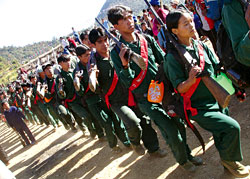|
|
Certification of guerrillas and their weapons is a cornerstone of the peace process. This is what the success and credibility of the cantonment and 'arms management' hinges on. But certification is exactly what the 12-page long peace agreement leaves vague. The best the seven parties and the Maoists could come up with after six days of discussion was an agreement to "solve the issue of certification at the suggestion of the UN."
The deal does agree that 'People's Liberation Army' soldiers under18, and those recruited after 26 May this year will not be in the camps. Which seems fair enough, until it becomes apparent that there is no mechanism to determine how minors and new recruits are to be identified.
Human rights watchdog Insec estimates that the Maoists' 8-21 November recruitment drive right before the peace deal was signed added almost 5,000 people to their army. Insec cautions that this figure does not include new cadres recruited in remote areas. 
In Palpa, for example, five of 150 students taken away returned to the district headquarters and testified that they were undergoing military training and had been told to say that they'd already spent two years in the PLA. In Ilam, a 13-year-old new recruit accidentally killed another teenager while learning to handle a .303 rifle.
Padam Pun reports from Rukum that the Maoists opened a temporary recruitment office and promised young people who signed up positions in the national army commensurate with their educational qualifications. Right now in Rukum students from grade five to college levels are receiving military training from the PLA.
Establishing who is a minor is difficult in the first place because not everyone has citizenship, educational and birth registration certificates. When people do have them, the paperwork often sports arbitrary birthdates. The Maoists are also likely to argue that their fighters have been unable to get citizenship certificates because of the conflict.
In places where the Maoists claimed they had set up a 'new system' people were effectively prohibited from obtaining documents like citizenship papers from the 'old regime'. Birth registration in rural areas is a hit-or-miss affair, which is also to the advantage of the Maoists.
It is also difficult to identify who was recruited after 26 May, as many of these new fighters have had five months of training and indoctrination already. Those taken away by force, or tempted with offers of employment in the national army, are unlikely to speak out against the Maoist party.
The Maoists, for their part, understand the importance of keeping sweet the thousands of children they've used as porters, informers, guides, technicians, and cultural groups, or worse, those who have been tortured or lost limbs for the cause.
The party has a real numbers problem. At their meeting in September last year in Chunbang, Rukum, the Maoists claimed in a show of strength directed at the royal regime, to have seven divisions. In reality, the PLA had three divisions and needed about 23,000 new soldiers to add four more. They could barely recruit 1,000. The contribution from their strongholds in Rukum and Rolpa was a paltry 300 youth. They are thus now even willing to canton their militia, to make up the numbers.
The Maoists will also have to deal with the internationally-accepted 'one man, one weapon' model for guerrilla certification. Best estimates are that the PLA has around 7,000 weapons looted from the army and police, 5,000 taken from villages, and 300 bought from India. Again, to make up numbers, the Maoists thus demand that khukuris, socket and pressure cooker bombs also be considered as weapons



